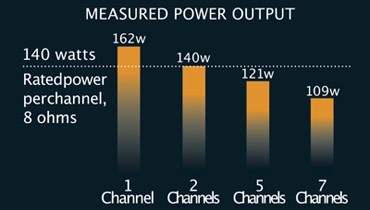Integra DTR-8.8 A/V receiver Page 3

TEST BENCH
DOLBY DIGITAL PERFORMANCE
All data were obtained from various test DVDs using 16-bit dithered test signals, which set limits on measured distortion and noise performance. Reference input level is -20 dBFS, and reference output is 1 watt into 8 ohms. Volume setting for reference level was -8. All level trims at zero, except for subwoofer-related tests, all speakers were set to "large," subwoofer on. All are worst-case figures where applicable.
Output at clipping (1 kHz into 8/4 ohms) 1 channel driven: 162/254 W (22.1/24 dBW) 5 channels driven (8 ohms): 121 W (20.8 dBW) 7 channels driven (8 ohms): 109 W (20.4 dBW) Distortion at 1 watt (THD+N, 1 kHz) 8/4 ohms: 0.03/0.04% Noise level (A-wtd): -76.0 dB Excess noise (with sine tone) 16-bit (EN16): 0.3 dB Frequency response: 20 Hz to 20 kHz +0, -0.3 dB
MULTICHANNEL PERFORMANCE, ANALOG INPUT
Reference input and output level is 200 mV; volume setting for reference output level was -4. Distortion (THD+N, 1 kHz, 8 ohms): 0.004% Noise level (A-wtd.): -93.1 Frequency response: < 10 Hz to 166 kHz +0, -3 dB
STEREO PERFORMANCE, DIGITAL INPUT
Reference level is -20 dBFS; all level trims at zero. Volume setting for reference level was -4. Output at clipping (1 kHz, 8/4 ohms, both channels driven): 140/216 W (21.5/23.3 dBW) Distortion at reference level: 0.02% Linearity error (at -90 dBFS): 0.1 dB Noise level (A-wtd): -75.6 dB with 96-kHz/24-bit signals: -88.8 dB Excess noise (with/without sine tone) 16-bit (EN16): 0.1/0.0 dB quasi-20-bit (EN20): 7.2/6.4 dB Noise modulation: 0 dB Frequency response: < 10 Hz to 20 kHz +0, -0.3 dB with 96-kHz/24-bit signals: < 10 Hz to 45 kHz +0, -1.5 dB<</p>
BASS-MANAGEMENT PERFORMANCE
Measured results obtained with Dolby Digital test signals. Subwoofer-output frequency response (crossover set to 80 Hz): 24 dB/octave (approx.) above -6-dB rolloff point of 80 Hz High-pass-filter frequency response (crossover set to 80 Hz): 12 dB/octave below -3-dB rolloff point of 80 Hz Maximum unclipped subwoofer output (trim at 0): 7.9v Subwoofer distortion (from 6-channel, 30-Hz, 0-dBFS signal; subwoofer trim set to 0): 0.03% Crossover consistency: bass crossover frequency and slope were consistent for all sources and formats Signal-format consistency: consistent for all applicable formats Speaker size selection: all channels can be set to "small" Speaker-distance compensation: available for all main channels.
Integra's new line-topping DTR8.8 receiver produced power numbers that handily matched its specifications, including spot-on 140w stereo power and output that fell by a scant 0.3 dB (121 watts) with 5 channels driven (and just another 0.4 dB with all 7 channels working). The preceding reflect performance with the unit's software-setup switch set to the "6 ohm" position; with the switch set for 4 ohms, power was restricted to about 60 watts under all conditions, presumably by intentional current limiting. Like most such designs the receiver protected itself by cutting drive in half when confronted with extended, multichannel clipping, but I would hardly expect this to occur under actual program conditions (and protection quickly switched out when signal levels were decreased).
In every other regard the DTR8.8's test-bench behavior was exemplary. Indeed, I believe this to be in sum the best such set of numbers I've seen from an AV receiver. On our real-world dithered-tone trials, signal-to-noise in all tests was essentially at the theoretical minimum (and analog-domain S/N was just as impressive), while linearity, noise-modulation, and excess-noise measurements were all virtually perfect. Well done, Integra!














































